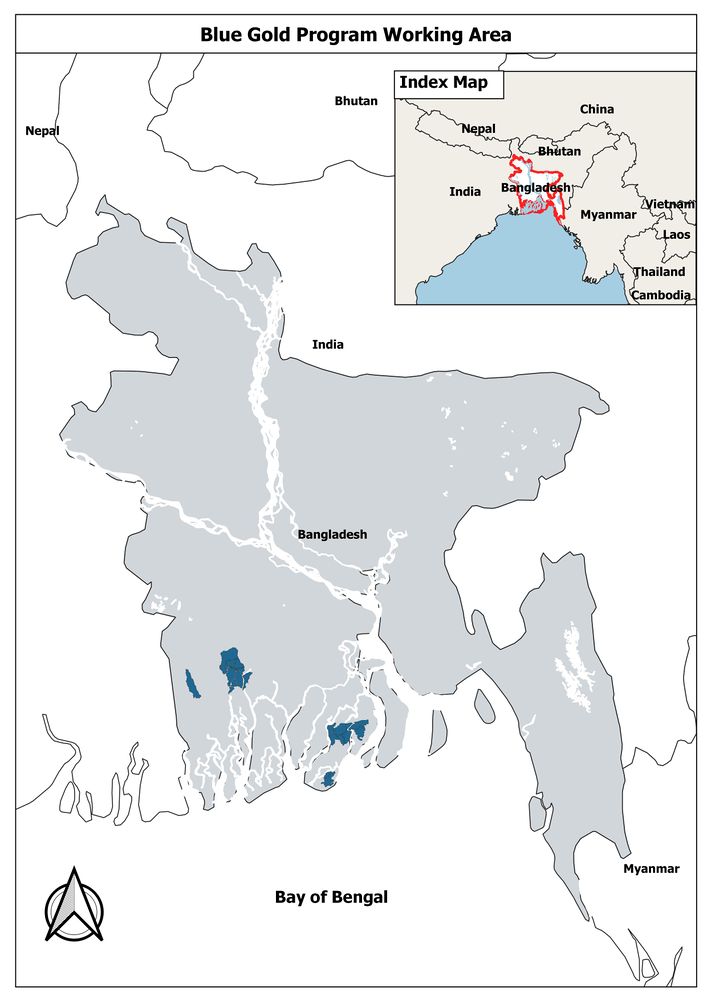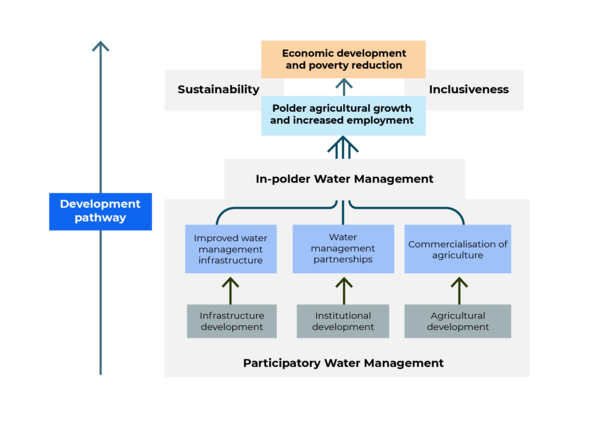Views
Actions
Summary of Section A: Background and context
This section provides background and context for lessons learnt during the Blue Gold Program by providing a description of the project, its ambitions, resources, and underpinning concepts. It will also detail ‘the setting’ (institutions, social and physical context, previous experiences, the enabling environment of policies, laws and regulations) in which the project was implemented, as well as describe how the Participatory Water Management approach defined at the project’s start evolved during the seven-year implementation period.
BGP postulates that ‘water management for development’- the combining of water infrastructure and locally-led initiatives for better water management with a transformative approach to smallholder agriculture- provides a robust pathway to development.
The purpose of this wiki is to present this pathway and the many lessons that help to describe it. Blue Gold Program lessons serve as input for the definition of future water sector investments in Bangladesh’s coastal zone, and as a contribution to policy choices on Bangladesh’s water sector governance. Both investment decisions and policy choices take place under the aegis of the Delta Plan 2100.
The project: the Blue Gold Program[edit | edit source]
| Blue Gold Program | |
|---|---|
| The Blue Gold Program (2013-2021) promotes Participatory Water Management in 22 polders in the southwestern coastal belt by: | |
| Improving water management | |
| Increasing and diversifying agricultural production | |
| Increasing income and employment through market-led agriculture | |
| Reducing poverty and improving food security | |
| Using a pro-poor, inclusive approach, targeting men and women, to include all polder inhabitants and also to enhance development outcomes | |
The Blue Gold Program is funded by the governments of Bangladesh and the Netherlands and aims to reduce poverty for 185,000 households in the coastal districts of Patuakhali, Khulna, Satkhira, and part of Barguna. Blue Gold helps local communities stabilise their environments, and pursue sustainable socio-economic development through participatory water management and diversified farming practices with an increased orientation on markets. It aims to reduce poverty and enhance food security by strengthening the institutional framework, water resources infrastructure and through agricultural transformation.
Setting: the coastal zone[edit | edit source]
Over 1 million hectares of agricultural lands were enclosed in polders in the 1960s and 1970s to provide protection from tidal flooding and saline water intrusion. Now, these polders are home to about 10 million people. Yet, despite the enormous investment in embankments and associated infrastructure, some 38% of rural households in the polders live below the national poverty line. The polders are subjected to flooding during the rainy season, drought and salinity during the dry season, as well as cyclones. As a result, productivity is low. These problems will be exacerbated by climate change and sea-level rise over time.[1]
Participatory Water Management[edit | edit source]
The Blue Gold Program functions within the country policy and legal framework for Participatory Water Management (PWM). This framework, of which the basic principles were laid down some 20 years back, structures the involvement of communities in water management through a nested structure of Water Management Groups and Water Management Associations, which are to be formally given responsibility for routine maintenance and operation of water infrastructure.
Water management for development[edit | edit source]
Through its implementation period, BGP sought to bring the benefits of water management to all corners of the polders. Increased agricultural returns through better in-polder water management provide a reason for polder inhabitants to assume operation and maintenance responsibilities and to contribute to their cost.
To promote in-polder water management, BGP intervenes in three realms:
- Infrastructure development: complementing rehabilitation works on embankments, sluices and main drainage channels with small-scale works within the polders’ internal water systems
- Institutional development: strengthening recently established water management organisations by the development of their networks and partnerships with local governments, departments and the private sector
- Agricultural development: Aiming to bring the benefits of commercial agriculture through the dissemination of knowledge on field crop production, support to diversified homestead production and support to market linkages.
Purpose of the ‘lessons learnt’ wiki[edit | edit source]
This wiki records lessons learnt for use in the design and implementation of future interventions in the coastal zone.
The purpose of this wiki is to pass on this knowledge and experience to the planners and policymakers working towards the realisation of the Delta Plan, and to those responsible for the design and implementation of future projects in the coastal zone.
| The way forward | |
|---|---|
| The Blue Gold Program and other PWM projects apply the existing legal, regulatory and institutional framework. Given the proven potential of participatory water management for enhancing development, the time has come to reassess the enabling framework for PWM. The experience of BGP suggests rethinking the following: | |
| Participatory water management must be initiated and supported. But where is the institutional capacity to do so at a nationwide scale? | |
| Water Management Groups and Associations flourish when working closely with Local Government Institutions and line agencies. How can this partnership be extended to the whole country? | |
| Water Management Groups and Associations develop small-scale infrastructure but also are stakeholders in the main infrastructure. How can the planning of small and large-scale infrastructure be optimised to complement each other? | |
| New legislation establishes local and regional water resource committees. How can such bodies enhance the synergy between national, regional and local interest? | |
References[edit | edit source]
- ↑ "Blue Gold Program". Blue Gold Program. Retrieved July 8, 2020.
Table of contents[edit | edit source]
| Chapter 01: Overview, Purpose and Structure of Report | Chapter 02: Institutional Setting | Chapter 03: Social, Physical and Environmental Context |
|---|---|---|
| Chapter 04: Policy framework, history of interventions and project definition |
|---|
|
See more[edit | edit source]
| Blue Gold Wiki | |||||||||||||||||||
|---|---|---|---|---|---|---|---|---|---|---|---|---|---|---|---|---|---|---|---|
|

